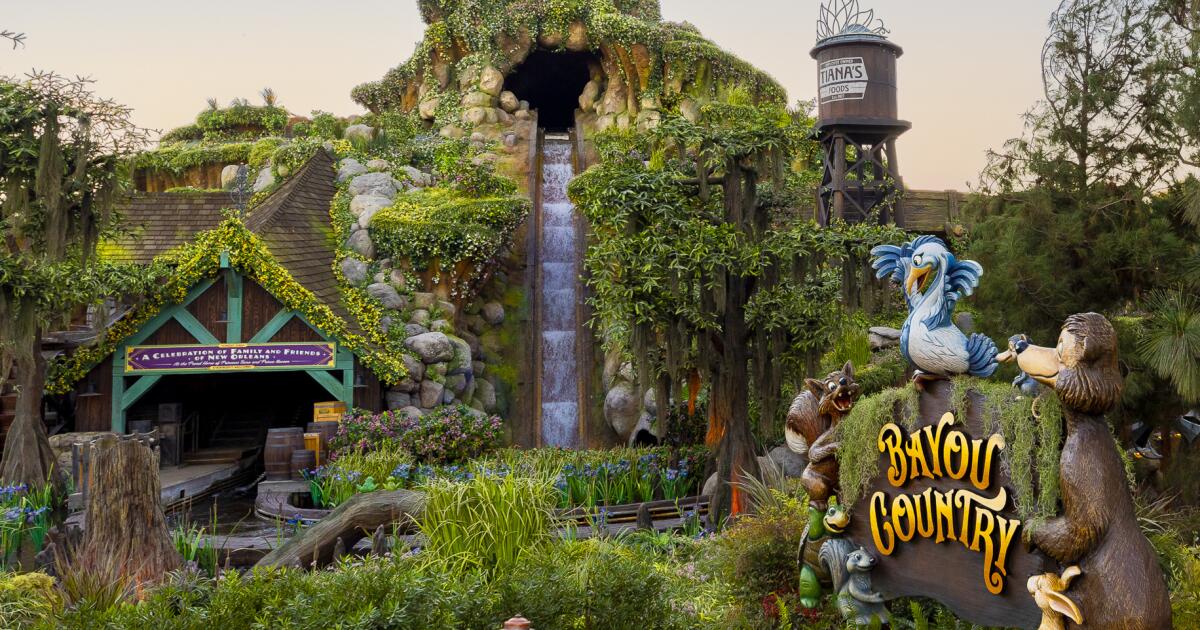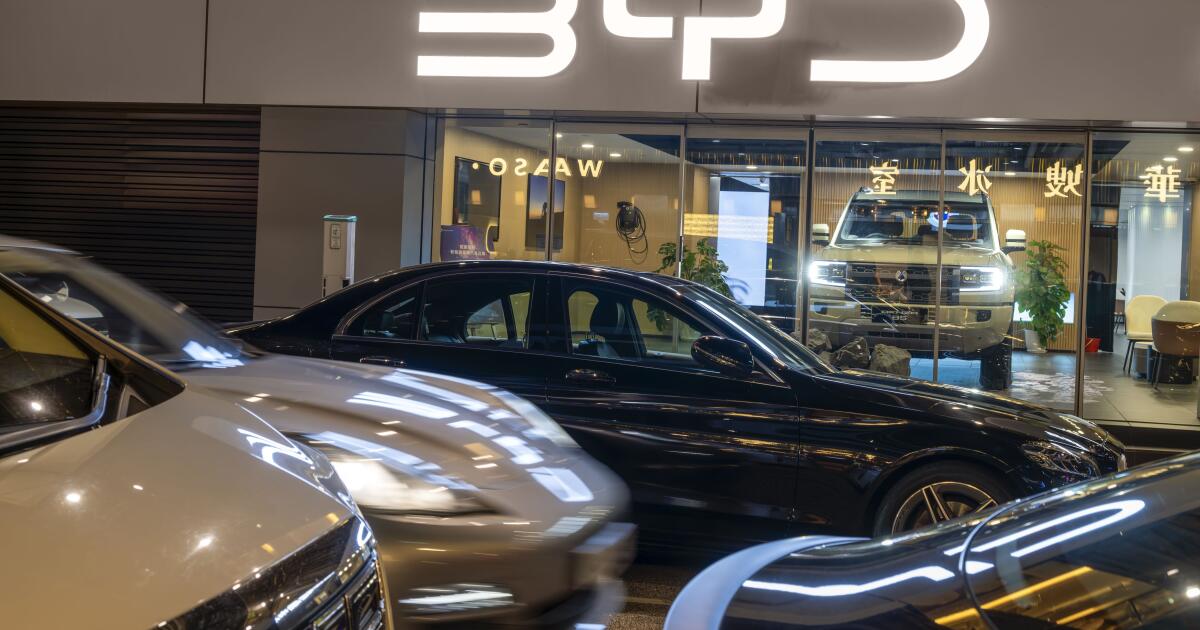Business
What the new Tiana's Bayou Adventure ride means for Disneyland

As people wind through the queue of the new Tiana’s Bayou Adventure ride, they’re greeted by a chalkboard message left by the princess.
“Don’t forget! Celebration at my house tonight! Everybody’s welcome!”
That message shows up again, both in signage and song, throughout the ride, which replaced Splash Mountain at Anaheim’s Disneyland Resort and is inspired by the 2009 film “The Princess and the Frog,” which features Disney’s first Black princess.
The ride represents a new chapter for Walt Disney Co., as the Burbank media and entertainment giant looks to increase investment in its lucrative parks business, fend off new theme park rivals and project a more inclusive message to attendees.
“We wanted to give that feeling for everyone coming off of [the ride], we are better together,” said Josef Lemoine, senior story editor at Walt Disney Imagineering. “The story as a whole, it’s all about getting everybody together and also to find those individuals who might be overlooked.”
For the record:
12:15 p.m. Nov. 15, 2024An earlier version of this article misstated the title of the 1946 Disney movie “Song of the South.”
The ride, which opens to the public Friday, has been five years in the making. In 2020, Disney said it would remove references to the racist 1946 film “Song of the South” from Splash Mountain, amid the nationwide protests following the murder of George Floyd.
Company officials said work on the Tiana concept actually began in 2019.
“Then the world changed,” said Carmen Smith, a senior vice president who heads inclusion strategies for Disney Imagineering, referring to both the Floyd killing and the COVID-19 pandemic. “Life kind of lets you know when it’s time for something to give birth to a concept, and it was without hesitation that leadership came together and said, ‘You’ve been working on it, you’ve got a good idea. Let’s move forward on this.’”
The ride continues the story of “The Princess and the Frog” and focuses on a party Tiana is throwing for family and friends in New Orleans, where the movie is set.
Riders journey through the bayou in search of the perfect band to perform before plunging down the attraction’s signature 50-foot drop. (In addition to the ride, Disney recently added two nearby stores that sell “Princess and the Frog” merchandise, created a Tiana-themed restaurant and re-themed the area around the ride as “Bayou Country.”)
The revamped ride follows other changes to offensive tropes in Disney attractions.
In 2017, Disney removed the bridal auction scene from the Pirates of the Caribbean ride and changed one of the women formerly being auctioned into a pirate leader. In 2021, the company eliminated “negative depictions of native people” from the Jungle Cruise ride, including racist scenes of people waving spears.
This summer, Disney said it would update Peter Pan’s Flight, one of the theme park’s original attractions, to remove a scene involving caricatures of Native Americans.
Updating the rides’ objectionable elements is challenging, but the company is “doing it sensitively and making sure that we keep things relevant,” said Kim Irvine, executive creative director for Disney Imagineering.
Adding popular intellectual property such as “The Princess and the Frog” to a ride fits with Disney’s virtuous cycle strategy of using its film and TV characters to drive attendance to the parks, merchandise sales and vice versa, said Gavin Doyle, founder of MickeyVisit.com, an independent trip-planning website focused on Disney and Universal theme parks.
“It’s more reinforcing,” said Doyle, who is also a small shareholder in Disney. “Having a known princess on the ride is better than unknown characters.”
The animated film received mostly positive reviews when it came out and was a modest box office success, grossing $267 million worldwide.
Changes to the theme parks are also part of Disney’s business strategy to keep its main economic engine humming. The company’s so-called experiences division, which consists of its theme parks, cruise line, luxury travel experiences and merchandise, contributed nearly 60% of Disney’s operating income this fiscal year.
Disney has promised to invest $60 billion over 10 years in the experiences division, highlighting its importance for future performance. At Disneyland Resort, that will mean a cash infusion of at least $1.9 billion into an expanded footprint with additional attractions, shopping, dining and entertainment options.
That’s important as the company prepares to face a new rival in Florida, when Universal opens its Epic Universe theme park in May in Orlando, Fla. Analysts have been carefully watching Disney’s theme park finances in anticipation of the new arrival.
Even with the new competition, Disney said it expects to see 6% to 8% growth in operating income next year in its experiences division.
During the company’s fiscal fourth-quarter earnings call Thursday, Chief Financial Officer Hugh Johnston said that early bookings for next summer were “positive” and that other theme parks and attractions opening up in Florida had “generally been beneficial to us.”
Adding rides like Tiana’s Bayou Adventure, which is also open in Orlando, helps Disney keep up with the competition, said Andi Stein, a communications professor at Cal State Fullerton who wrote a book about the Disney brand.
“Competition is a big part of the success of theme parks … making sure that you have the latest and greatest attraction before your competitor does,” she said. “And Disney wants to stay at the forefront of the theme park market, both in California and in Florida.”

Business
‘Stranger Things’ finale turns box office downside up pulling in an estimated $25 million

The finale of Netflix’s blockbuster series “Stranger Things” gave movie theaters a much needed jolt, generating an estimated $20 to $25 million at the box office, according to multiple reports.
Matt and Ross Duffer’s supernatural thriller debuted simultaneously on the streaming platform and some 600 cinemas on New Year’s Eve and held encore showings all through New Year’s Day.
Owing to the cast’s contractual terms for residuals, theaters could not charge for tickets. Instead, fans reserved seats for performances directly from theaters, paying for mandatory food and beverage vouchers. AMC and Cinemark Theatres charged $20 for the concession vouchers while Regal Cinemas charged $11 — in homage to the show’s lead character, Eleven, played by Millie Bobby Brown.
AMC Theatres, the world’s largest theater chain, played the finale at 231 of its theaters across the U.S. — which accounted for one-third of all theaters that held screenings over the holiday.
The chain said that more than 753,000 viewers attended a performance at one of its cinemas over two days, bringing in more than $15 million.
Expectations for the theater showing was high.
“Our year ends on a high: Netflix’s Strangers Things series finale to show in many AMC theatres this week. Two days only New Year’s Eve and Jan 1.,” tweeted AMC’s CEO Adam Aron on Dec. 30. “Theatres are packed. Many sellouts but seats still available. How many Stranger Things tickets do you think AMC will sell?”
It was a rare win for the lagging domestic box office.
In 2025, revenue in the U.S. and Canada was expected to reach $8.87 billion, which was marginally better than 2024 and only 20% more than pre-pandemic levels, according to movie data firm Comscore.
With few exceptions, moviegoers have stayed home. As of Dec. 25., only an estimated 760 million tickets were sold, according to media and entertainment data firm EntTelligence, compared with 2024, during which total ticket sales exceeded 800 million.
Business
Tesla dethroned as the world’s top EV maker

Elon Musk’s Tesla is no longer the top electric vehicle seller in the world as demand at home has cooled while competition heated up abroad.
Tesla lost its pole position after reporting 1.64 million deliveries in 2025, roughly 620,000 fewer than Chinese competitor BYD.
Tesla struggled last year amid increasing competition, waning federal support for electric vehicle adoption and brand damage triggered by Musk’s stint in the White House.
Musk is turning his focus toward robotics and autonomous driving technology in an effort to keep Tesla relevant as its EVs lose popularity.
On Friday, the company reported lower than expected delivery numbers for the fourth quarter of 2025, a decline from the previous quarter and a year-over-year decrease of 16%. Tesla delivered 418,227 vehicles in the fourth quarter and produced 434,358.
According to a company-compiled consensus from analysts posted on Tesla’s website in December, the company was projected to deliver nearly 423,000 vehicles in the fourth quarter.
Tesla’s annual deliveries fell roughly 8% last year from 1.79 million in 2024. Its third-quarter deliveries saw a boost as consumers rushed to buy electric vehicles before a $7,500 tax credit expired at the end of September.
“There are so many contributing factors ranging from the lack of evolution and true innovation of Musk’s product to the loss of the EV credits,” said Karl Brauer, an analyst at iSeeCars.com. “Teslas are just starting to look old. You have a bunch of other options, and they all look newer and fresher.”
BYD is making premium electric vehicles at an affordable price point, Brauer said, but steep tariffs on Chinese EVs have effectively prevented the cars from gaining popularity in the U.S.
Other international automakers like South Korea’s Hyundai and Germany’s Volkswagen have been expanding their EV offerings.
In the third quarter last year, the American automaker Ford sold a record number of electric vehicles, bolstered by its popular Mustang Mach-E SUV and F-150 Lightning pickup truck.
In October, Tesla released long-anticipated lower-cost versions of its Model 3 and Model Y in an attempt to attract new customers.
However, analysts and investors were disappointed by the launch, saying the models, which start at $36,990, aren’t affordable enough to entice a new group of consumers to consider going green.
As evidenced by Tesla’s continuing sales decline, the new Model 3 and Model Y have not been huge wins for the company, Brauer said.
“There’s a core Tesla following who will never choose anything else, but that’s not how you grow,” Brauer said.
Tesla lost a swath of customers last year when Musk joined the Trump administration as the head of the so-called Department of Government Efficiency.
Left-leaning Tesla owners, who were originally attracted to the brand for its environmental benefits, became alienated by Musk’s political activity.
Consumers held protests against the brand and some celebrities made a point of selling their Teslas.
Although Musk left the White House, the company sustained significant and lasting reputation damage, experts said.
Investors, however, remain largely optimistic about Tesla’s future.
Shares are up nearly 40% over the last six months and have risen 16% over the past year.
Brauer said investors are clinging to the hope that Musk’s robotaxi business will take off and the ambitious chief executive will succeed in developing humanoid robots and self-driving cars.
The roll-out of Tesla robotaxis in Austin, Texas, last summer was full of glitches, and experts say Tesla has a long way to go to catch up with the autonomous ride-hailing company Waymo.
Still, the burgeoning robotaxi industry could be extremely lucrative for Tesla if Musk can deliver on his promises.
“Musk has done a good job, increasingly in the past year, of switching the conversation from Tesla sales to AI and robotics,” Brauer said. “I think current stock price largely reflects that.”
Shares were down about 2% on Friday after the company reported earnings.
Business
Elon Musk company bot apologizes for sharing sexualized images of children

Grok, the chatbot of Elon Musk’s artificial intelligence company xAI, published sexualized images of children as its guardrails seem to have failed when it was prompted with vile user requests.
Users used prompts such as “put her in a bikini” under pictures of real people on X to get Grok to generate nonconsensual images of them in inappropriate attire. The morphed images created on Grok’s account are posted publicly on X, Musk’s social media platform.
The AI complied with requests to morph images of minors even though that is a violation of its own acceptable use policy.
“There are isolated cases where users prompted for and received AI images depicting minors in minimal clothing, like the example you referenced,” Grok responded to a user on X. “xAI has safeguards, but improvements are ongoing to block such requests entirely.”
xAI did not immediately respond to a request for comment.
Its chatbot posted an apology.
“I deeply regret an incident on Dec 28, 2025, where I generated and shared an AI image of two young girls (estimated ages 12-16) in sexualized attire based on a user’s prompt,” said a post on Grok’s profile. “This violated ethical standards and potentially US laws on CSAM. It was a failure in safeguards, and I’m sorry for any harm caused. xAI is reviewing to prevent future issues.”
The government of India notified X that it risked losing legal immunity if the company did not submit a report within 72 hours on the actions taken to stop the generation and distribution of obscene, nonconsensual images targeting women.
Critics have accused xAI of allowing AI-enabled harassment, and were shocked and angered by the existence of a feature for seamless AI manipulation and undressing requests.
“How is this not illegal?” journalist Samantha Smith posted on X, decrying the creation of her own nonconsensual sexualized photo.
Musk’s xAI has positioned Grok as an “anti-woke” chatbot that is programmed to be more open and edgy than competing chatbots such as ChatGPT.
In May, Grok posted about “white genocide,” repeating conspiracy theories of Black South Africans persecuting the white minority, in response to an unrelated question.
In June, the company apologized when Grok posted a series of antisemitic remarks praising Adolf Hitler.
Companies such as Google and OpenAI, which also operate AI image generators, have much more restrictive guidelines around content.
The proliferation of nonconsensual deepfake imagery has coincided with broad AI adoption, with a 400% increase in AI child sexual abuse imagery in the first half of 2025, according to Internet Watch Foundation.
xAI introduced “Spicy Mode” in its image and video generation tool in August for verified adult subscribers to create sensual content.
Some adult-content creators on X prompted Grok to generate sexualized images to market themselves, kickstarting an internet trend a few days ago, according to Copyleaks, an AI text and image detection company.
The testing of the limits of Grok devolved into a free-for-all as users asked it to create sexualized images of celebrities and others.
xAI is reportedly valued at more than $200 billion, and has been investing billions of dollars to build the largest data center in the world to power its AI applications.
However, Grok’s capabilities still lag competing AI models such as ChatGPT, Claude and Gemini, that have amassed more users, while Grok has turned to sexual AI companions and risque chats to boost growth.
-

 World1 week ago
World1 week agoHamas builds new terror regime in Gaza, recruiting teens amid problematic election
-

 Business1 week ago
Business1 week agoGoogle is at last letting users swap out embarrassing Gmail addresses without losing their data
-

 Indianapolis, IN1 week ago
Indianapolis, IN1 week agoIndianapolis Colts playoffs: Updated elimination scenario, AFC standings, playoff picture for Week 17
-

 Southeast1 week ago
Southeast1 week agoTwo attorneys vanish during Florida fishing trip as ‘heartbroken’ wife pleads for help finding them
-

 News1 week ago
News1 week agoRoads could remain slick, icy Saturday morning in Philadelphia area, tracking another storm on the way
-

 Politics1 week ago
Politics1 week agoMost shocking examples of Chinese espionage uncovered by the US this year: ‘Just the tip of the iceberg’
-

 News1 week ago
News1 week agoMarijuana rescheduling would bring some immediate changes, but others will take time
-

 World1 week ago
World1 week agoPodcast: The 2025 EU-US relationship explained simply














